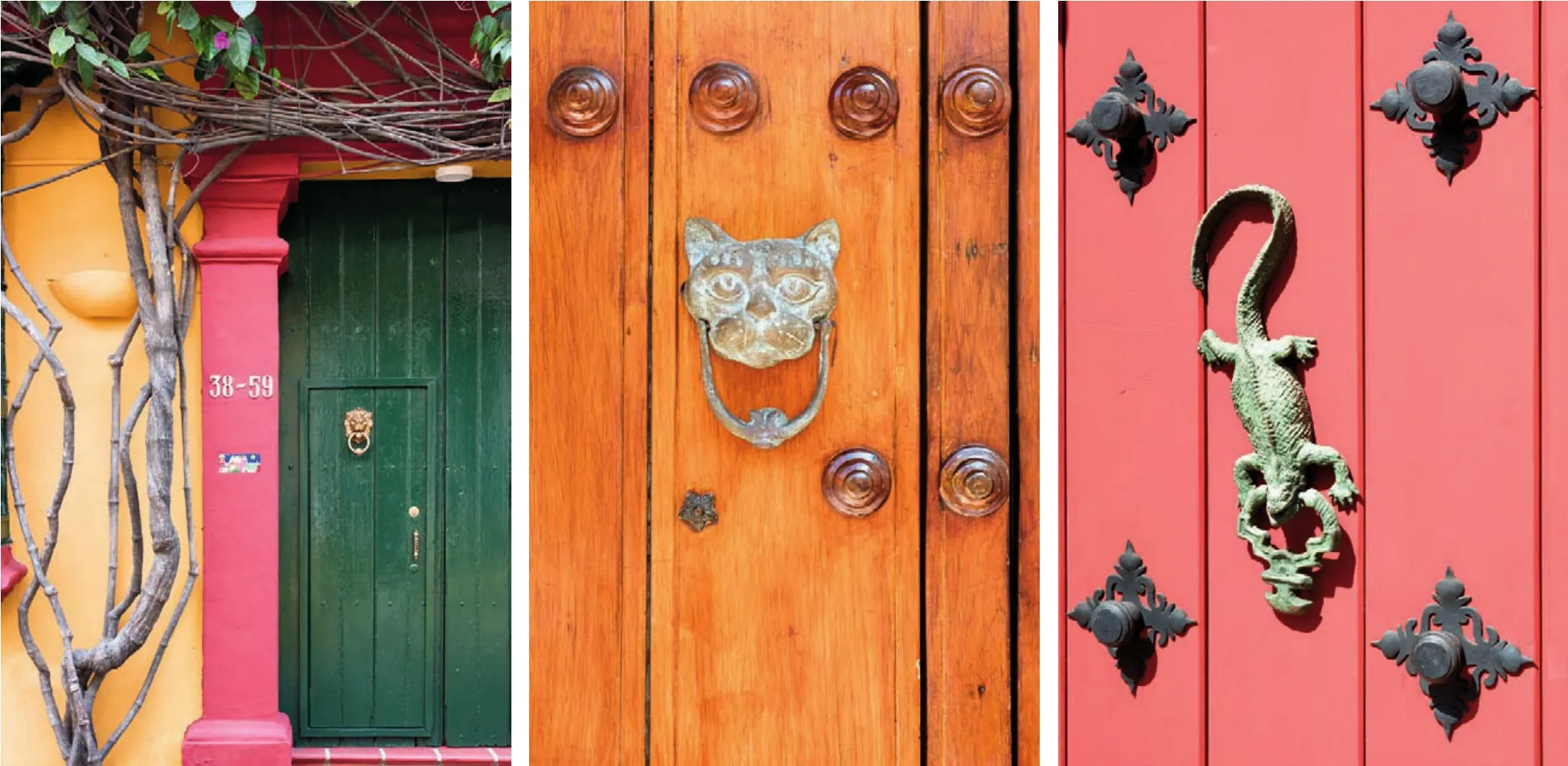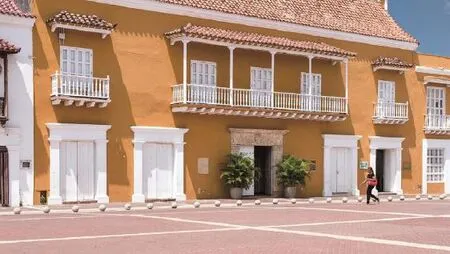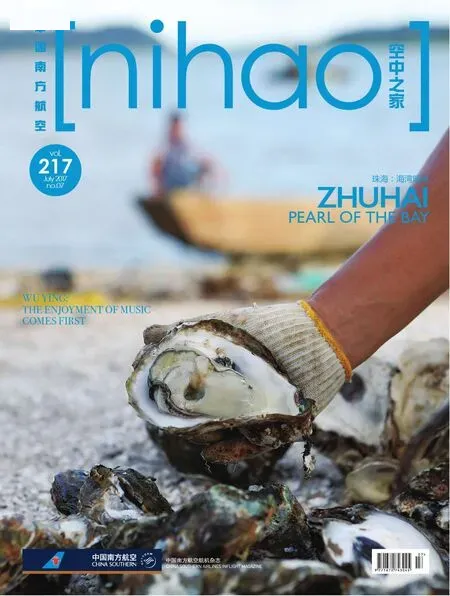COLOMBIAN COLORS
Text & Photos by Peter Weld
COLOMBIAN COLORS
Text & Photos by Peter Weld
哥伦比亚为“色”钟情
过去几十年里,哥伦比亚一直笼罩在浓重的负面影响之中,近年来,她成绩斐然,将不堪的过往甩到身后。从北部的卡塔赫纳到南部的波帕扬,如今的哥伦比亚是南美旅游地的佼佼者,其文化与色彩的活力足以比肩同一片大陆上的任何国家。

Once used as a jail, Las Bovedas now houses a popular row of souvenir shops in Cartagena.前身为监狱的Las Bovedas现在成为纪念品商店聚集地。
Doors and More
The city of Cartagena was founded in 1533 by Pedro de Heredia, a Spanish conquistador, and for nearly fi ve centuries it has served as a doorway to South America. From here, Spanish settlers spread out across Colombia and far beyond. Explorers arrived to look for legendary cities of gold. Merchants came in search of things to trade. Slaves were brought here forcibly from Africa to work on plantations. Tourists came to see the wonders of“The New World.”
Today the situation has changed a lot: slavery is illegal, of course, and few people believe in cities of gold any more. With the rise of plane travel, merchants are more likely to fl y directly to the country's capital, Bogot‡, or to the cities of Medellin and Cali. But tourists continue to sail into Colombia's fi fth-largest city, Cartagena—nowadays on giant cruise ships—and it's still a great place for doorways.
I noticed them everywhere as I strolled the lanes of the historic district of Cartagena: grand old wooden doors, painted in an array of bright colors, with impressive brass knockers. The most common knocker designs included lizards and lions, but with a bit of searching I also found cats, turtles, fi sh, and my personal favorite, a huge octopus on the door leading into a sushi restaurant. (Amusingly, though, many of these big doors had smaller doors set into them, and it was only through the smaller doors that people came and went.)
Cartagena served as a gateway not only for people arriving in South America but also for natural resources and pillaged treasures being sent back to Spain, so not surprisingly it became a prime target for pirates and state-sponsored raiders alike. Among them was the English vice admiral Francis Drake, who arrived in 1586 with 23 ships and 3,000 men; he didn't leave until a month later, having ravaged the city and extracted a hefty ransom. The Spanish government realized then that it had toget serious about defending Cartagena, so it hired an Italian, Battista Antonelli, to design fortifi cations. The plan that he came up with—some eleven kilometers of thick battlements and forts—took decades to implement, but when it was fi nally done, Cartagena had been transformed into one of the best-protected settlements on the entire continent.
Pirates and raiders are nowhere in evidence in 21st-century Cartagena, but the wall still serves an important function: it's where everyone goes in the late afternoon and early evening to see and to be seen. A brisk breeze blows in off the Caribbean as people stroll and bicycle along the top of the wall. (That same breeze makes the surf surprisingly rough, with the result that Cartagena's beaches are not the right place for lounging in a swimsuit while sipping a pi–a colada.) By the time the sun has set, most strollers and bicyclists have already left for one of the city's restaurants—perhaps including the sushi restaurant with the octopus-shaped door knocker.
五彩门户
在长达五百年的时间里,卡塔赫纳都是南美洲的门户。经由卡塔赫纳,西班牙殖民者涌入了哥伦比亚。探险者来此寻找传说中埋藏金矿的城市;商人来此寻找可供买卖的货物;非洲的奴隶被强掳到此,开荒种地;旅客来此领略“新世界”的风光。
现今,一切有了翻天覆地的改变:奴役是非法的,很少有人相信黄金城的传说了。商人更喜欢乘飞机直飞到哥伦比亚的首都波哥大。游客依然从海路来,只不过现在是乘坐巨型游轮。不变的是,卡塔赫纳仍是举足轻重的门户。
徜徉于卡塔赫纳的古城区,随处可见宏伟古老的木门。门板刷了鲜活色彩,嵌着醒目铜环。最常见的门环装饰物有蜥蜴、狮子,或其他动物。
卡塔赫纳既是通往南美的门户,又是西班牙殖民者掠夺资源的转运港,免不了被海盗与列强觊觎。为抵御攻击,西班牙殖民者筑起长达11公里的城墙。
21世纪的卡塔赫纳没有海盗和列强入侵,但城墙仍不可或缺:傍晚时分,几乎人人都要上来休闲,在海风中或散步,或骑行。

A stroll through the streets of Cartagena takes you past dozens of interesting doors.漫步卡塔赫纳街道,你会发现许多有趣的门。
Not Just a White City
Popay‡n is known throughout Colombia as“La Ciudad Blanca,” Spanish for “The White City.” Unlike in Cartagena and other Colombian cities which have preserved Spanish colonial architecture in all the colors of the rainbow, in Popay‡n the buildings in the historic district are mostly whitewashed. This unifying color scheme—or maybe “lack-of-color scheme” would be more accurate—gives Popay‡n's downtown a distinctly different look and feel.
But “White City” is just one of the Popay‡n's nicknames. It's also called “The Jerusalem of the Americas” because of the elaborate religious celebrations at Easter. In fact, the Easter festivities here are reckoned by some to be the second biggest in the world, behind only those in Seville, Spain. Palanquins bearing wooden statues of Jesus and other important fi gures from the Catholic religion are paraded through the streets of Popay‡n, with immense crowds watching.
I couldn't be there for the celebrations, but my visit came only about a month before Easter, which meant that everything in the city was being spruced up: a fresh coat of white was being applied wherever it was needed, and in a building near the central square, the wooden statues themselves were being taken carefully apart, repainted and repaired, and then put together again in preparation for their ride through the city streets.
Another of the city's nicknames is “The University City.” Popay‡n is the home of the University of Cauca, one of Colombia's oldest and most renowned institutions of higher education, having been established in 1827 by the country's president, Sim—n Bol’var, the famous “liberator” of South America. The university has nearly 13,000 students, and as I strolled the streets of the historic district, I often felt as though I was completely surrounded by students. I ventured into one of the university's buildings to explore. It took up an entire city block, but like most of the structures in the historic district, it wasn't one huge, white monolith; rather, it resembled a square donut: a two-storied building running around all four sides of a beautifully-tended courtyard.
The list of Popay‡n's nicknames isn't over yet. When UNESCO established its Creative Cities Network in 2004, Popayán became the fi rst city in the world to be given the title “City of Gastronomy.” (Since then, several other cities,including Chengdu and Shunde in China, have had the title conferred upon them.) The name is a bit deceptive: you might think that it should belong to the city with the most Michelin stars, but that's not the case. Rather, the title was given in recognition of the natural fusion cuisine to be found in Popay‡n: remnants of pre-Columbian culinary practices, heavily infl uenced by the colonists from Spain, and further refi ned by slaves brought over from Africa in the 1600s and 1700s.
And then there was the nickname that I gave Popay‡n: “City of Snacks.” To be honest, full meals there seemed to me to feature about the same dishes as in the rest of Colombia, but there is also a variety of snacks specifi c to this area. To get a taste of them, I stopped at a cafŽ called Mora Castilla, where I ended up consuming so many snacks that I didn't need dinner, snacks such as salpic—n payanŽs, a drink made with corn, pineapple, and a fruit that I'd never seen or heard of before: lulo.
“The White City,” “The Jerusalem of the Americas,” “The University City,” “City of Gastronomy,” “City of Snacks”—by the time I left, I was thinking of Popay‡n as “The City of Nicknames.”

Beautifully-preserved buildings from Colombia's days as a Spanish colony can be found all over the country.殖民地时期留下的建筑物遍布全国各地。
白色之城
波帕扬被誉为哥伦比亚的“白色之城”,古城区的建筑几乎全为白色。清一色的白为波帕扬平添一分独特美感。
波帕扬还有“美洲的耶路撒冷”的美称,因其复活节前会举办大型宗教活动。届时,耶稣及天主教其他重要人物的木像会由人抬着上街游行,参与游行的人为数众多。
“大学之城”是波帕扬的又一昵称。此地的考卡大学是哥伦比亚最古老、最负盛名的大学,有上万名学生。这所大学占地广,覆盖整个城区,建筑结构类似环形广场。
2004年,联合国教科文组织授予波帕扬“美食之都”的称号。不是因为有多家米其林餐厅,而是为褒扬当地自然融合的美食风格,在前哥伦布时期烹饪遗风的基础上融入了西班牙殖民者的口味,又有后期非洲奴隶的改良。
我也给波帕扬起了个昵称,“零食之城”。波帕扬的正餐与本国其他地方无甚分别,零食却颇具特色。为饱口福,我专门到咖啡馆点了各色零食,其中有种饮料,加了玉米、菠萝,和从未见过的果茄。
汇集众多昵称于一身,我以为,波帕扬是地道的“昵称之城”。

Top left: In front of the courthouse in Popayán there's a statue of José Mariá Obando, two-time president of Colombia.左上:在波帕扬法院门前,耸立着曾两度担任总统的何塞·马里亚·奥万多的雕像。

Top right: Popayán'scathedral had to be mostly rebuilt after a huge 1983 earthquake.右上:1983年大地震后重建的波帕扬大教堂。

Left: Two women dressed in the colors of the Colombian flag stand in front of Bogotá's Gold Museum.左:穿着哥伦比亚国旗色的两名女子在波哥大黄金博物馆前。
The Power of Gold
The fi rst Europeans arrived in what would later become Colombia in 1499, but they can hardly be considered to have discovered it: the area had already been inhabited for an estimated 5,000 years before that. Some of the indigenous people lived the simple lives of hunters and gatherers, but others had developed complex civilizations. And when the Spanish saw the elaborate gold jewelry worn by the rulers and upper classes of these civilizations, their eyes lit up with greed: they wanted to conquer the locals and get the gold. In the following centuries hundreds of thousands of local people died, some in battles with the Spanish but many more from diseases that the Spanish had unwittingly brought over with them.
Fast forward 500 years to the early 21st century. The vast majority of Colombians can trace their DNA back to the Spanish, to African slaves, or to both; indigenous people now account for only a small percentage of the country's population. But as in many other places around the world, modern Colombians have embraced the cultures that their ancestors tried so hard to exterminate.
With that thought in mind, I stepped rather tentatively into the Gold Museum at the edge of Bogot‡'s La Candelaria district. I don't usually visit museums because I fi nd them sterile, with everything behind glass which throws nasty refl ections into my photos—if photography is permitted at all. But the Gold Museum bowled me over. Room after room showed off the skill of the native goldsmiths: the jewelry they fashioned for kings and queens, the ceremonial implements they created for shamans' rituals, the funerary ornaments they made to be buried with people and carried to the afterlife. There were displays showing the variations in designs between different parts of the country as well as displays describing in detail how gold was panned, mined, smelted, annealed, hammered into shape, and more.
For me, the Gold Museum easily took the prize for Bogot‡'s most interesting place, but it was by no means the only attraction. I also enjoyed the Botero Museum, a tribute to Colombia's favorite artist, Fernando Botero. Now in his mid-eighties, he has spent over half a century painting and sculpting in his highly unusual style. “Fat” is the word that most people use while looking at Botero's art, but Botero himself is said to prefer the word “voluptuous.”Whatever adjective you choose, the style is unique: paintings of oversized men dancing with oversized women, statues of oversized babies and cats, even a stereotypical still life of a bowl of fruit—an incredibly oversized bowl containing several orchards' worth of fruit. The museum also includes works by Picasso and other artists, both famous and little known, but none of them manages to be as whimsical as Botero's.
My days in Bogot‡ passed peacefully. I toured some of the city's many churches, relaxed in decades-old cafŽs, and marveled at the colors of the main market. But the color most on my mind was gold, and before leaving, I made another, even longer trip through the Gold Museum. The use of fl ash is prohibited, but otherwise photography is no problem, and I spent several enthralling hours in there, admiring the exhibits all over again and happily photographing them. I felt as though I had been given an opportunity to travel back in time—a golden opportunity.

Once a week, local indigenous people, the Guambiano, come to the town of Silvia, near Popayán, to sell their vegetables.每周一次,当地土著人会到波帕扬附近的小镇出售蔬菜。
金色诱惑
第一批欧洲人到来前,哥伦比亚已有居民居住了几千年,他们有些过着简单的狩猎生活,有些已经发展出复杂的文明。西班牙人看到本地文明社会的黄金饰品时,生出贪念,要夺走黄金。不计其数的土著丧生于战争或疾病。
大部分哥伦比亚人都带有西班牙人、非洲人的基因,土著居民现只占全国人口的少数。现代的哥伦比亚人正拥抱着他们的祖先曾想根除的文化。
这样想着,我步入了波哥大的黄金博物馆。馆内一间间展厅陈列着当地金匠的手工艺品:有为国王和王后设计的首饰,有为巫师打造的法器,有为往生之人制作的随葬品。在此馆,可观赏哥伦比亚不同地区的设计风格,也可饱览各项黄金工艺的细节。
波特罗博物馆也是我喜欢的去处,以哥伦比亚著名艺术家费尔南多·波特罗的名字命名。
很多人爱用“肥胖”一词来形容波特罗的艺术,但据说波特罗本人更倾向用“饱满”。无论选择哪个词,他的作品风格都独一无二:肥男胖女共舞的画作,巨婴与壮猫的塑像,即便是老套的水果静物写生,也甚为夸张。
我在波哥大度过的日子十分平静,逛教堂,泡咖啡馆,惊叹市场的活力与缤纷,然而占据我脑海最多的颜色是金色。离开前,我又去了一次黄金博物馆,花上几小时重温展品,感觉就像亲身经历了一次穿越时空之旅——一次黄金之旅。
has
more than its share of negative publicity over the last few decades, but in more recent years the country has made great progress in putting its troubled past behind it. From Cartagena in the north to Popayán in the south, today's Colombia provides an excellent introduction to South American travel, with culture and colors vibrant enough to rival any other country on the continent.

